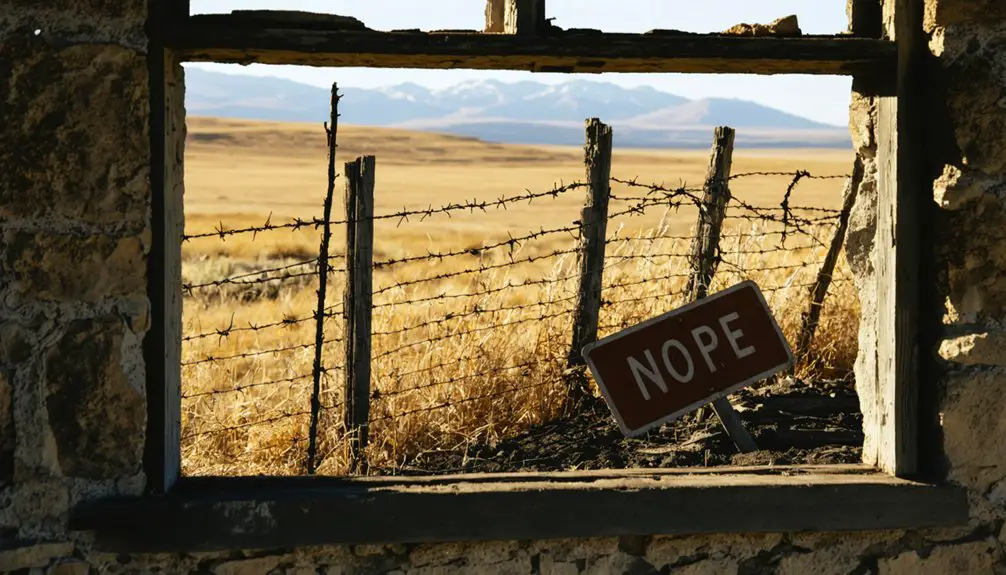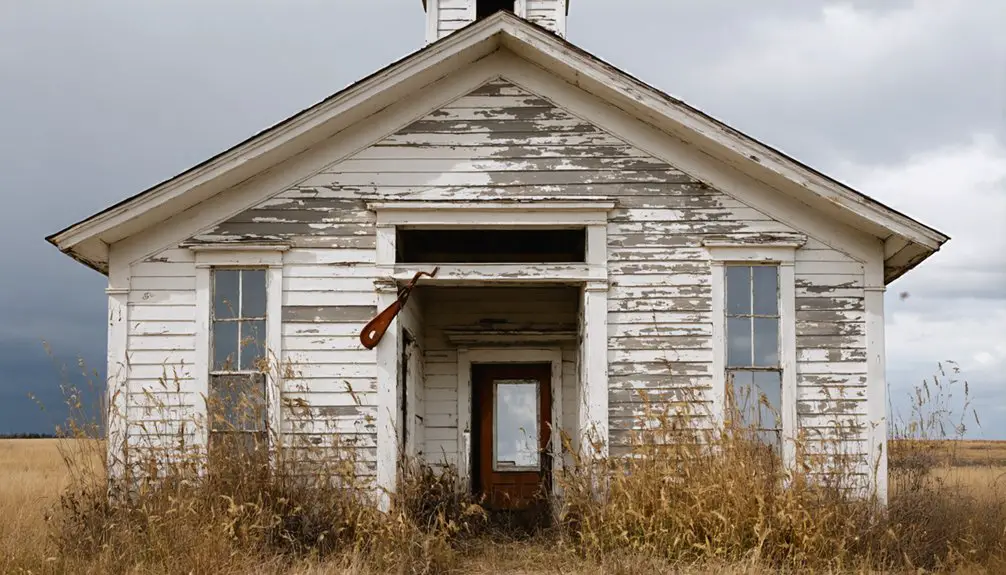You’ll discover Salem’s fascinating story as a Kansas ghost town established in White Mound Township, Jewell County in 1872. Founded by H.L. Browning, C.P. Miller, and George W. Smith, this agricultural hub grew to nearly 500 residents by 1883. The town thrived with a post office, high school, and Methodist church until 1887, when the Missouri Pacific Railroad‘s decision to bypass Salem triggered its decline. Salem’s transformation from bustling frontier settlement to abandoned prairie holds deeper lessons about westward expansion.
Key Takeaways
- Salem was established in 1872 in White Mound Township, Jewell County, Kansas, reaching its peak population of 500 residents between 1883-1888.
- The Missouri Pacific Railroad’s decision to bypass Salem in 1887 led to the town’s economic decline and eventual abandonment.
- The town featured a three-year high school, Methodist church, post office, and thriving commercial district during its prosperous years.
- Salem’s demise accelerated when businesses closed and younger residents left for better opportunities in nearby towns with railroad access.
- The closure of the post office marked a critical turning point in Salem’s transformation from a bustling community into a ghost town.
Early Days and Town Origins
The fertile lands of White Mound Township in Jewell County, Kansas became home to Salem when H.L. Browning, C.P. Miller, and George W. Smith laid out the town on January 25, 1872.
Taking strips from their adjoining farms, these founders chose a pleasant location that would attract settlers to the White Rock Valley, about ten miles east of Burr Oak.
The founding significance of Salem emerged even before the town’s official establishment, as Menzo W. Smith pioneered settlement in the area.
Before Salem was officially born, pioneer Menzo W. Smith had already laid the groundwork for this significant settlement.
You’ll find that early settlers quickly followed, drawn by the region’s agricultural promise and railroad access that supported the shipping of grain and livestock.
The community’s rapid development showed in the establishment of their post office on September 14, 1871, with George W.C. Smith serving as the first postmaster, marking Salem’s early commitment to connecting its growing population with the outside world.
The Wilson Brothers of Scandia became the first business occupants in March 1872, setting up shop in the town’s inaugural building.
Rise to Regional Prosperity
During Salem’s prime years between 1883 and 1888, this bustling Kansas town reached its zenith with nearly 500 residents and a thriving commercial district.
You’d have witnessed remarkable town growth as Salem established itself as an essential trading hub, supported by the rich agricultural lands surrounding it. Like the town of Midco, Salem became home to industrial operations that helped drive its early economic success.
The town’s business diversity expanded rapidly during this period, with merchants and traders setting up shops to serve the growing population. Similar to other Kansas towns like Shopa, local economies relied heavily on specialty crops, with prized pecans becoming a valuable commodity.
Salem’s prosperity was further enhanced by the establishment of key institutions – a three-year high school opened its doors, while a Methodist congregation organized in 1883 and built their church the following year.
The community’s central location and strong educational focus attracted families, with the school district reaching 134 students by 1888.
Community Life and Education
You’ll find Salem’s first steps into education began in 1883 when the growing town established a three-year high school to serve its expanding population.
Similar to rural communities like Kansas Falls, the education system relied heavily on dedicated teachers and basic facilities to provide learning opportunities for local children.
The school district played an essential role in Salem’s peak years, reaching its highest enrollment of 134 students in 1888.
Like Hesper Academy, which operated for nearly three decades, Salem’s educational institutions were vital to the community’s development.
The high school’s short-lived existence from 1883 to 1888 directly paralleled the town’s brief period of prosperity before the railroad’s fateful bypass altered Salem’s trajectory.
Early School District Formation
As settlers established roots in Jewell County during the early 1870s, Salem’s educational foundation took shape with the formation of School District No. 2 in 1872.
You’ll find that early education initiatives reflected the community’s grassroots commitment, with district organization meetings held in local homes and community buildings. Records show that J. S. Carson became the School District Director and Treasurer that same year.
Like many Kansas ghost towns that thrived as watering holes, Salem’s district quickly became central to community engagement, operating alongside newly established stores and churches during Salem’s formative years.
When the town reached its peak between 1883 and 1888, the educational system expanded to include a three-year high school.
This growth mirrored the broader development of Salem, demonstrating how deeply education was woven into the community’s fabric.
The district’s formation marked a significant milestone in Salem’s brief but vibrant history.
Three-Year High School
When Salem’s educational system reached maturity in the 1880s, the addition of a three-year high school marked a significant advancement for the growing community. The school operated a robust three-year curriculum spanning grades 10 through 12, combining fundamental academic subjects with vocational training tailored to local needs.
You’d find the brick schoolhouse near the town center, featuring modern amenities like science laboratories and a basement bicycle room. The facility served dual purposes – educating youth while hosting community gatherings, lectures, and civic events. By 1921, the district had grown to include twelve public schools, reflecting the area’s expanding educational needs. With an initial investment of $5,000, the schoolhouse represented a major commitment to education that far exceeded its original $2,000 budget.
A small faculty managed multiple subjects, often teaching both high school and elementary classes. Students from farming and merchant families attended classes scheduled around agricultural seasons, though enrollment fluctuated with harvest times.
The school fostered local pride while preparing students for higher education or skilled employment.
The Railroad’s Fateful Decision
In 1887, you’d have witnessed a pivotal moment in Salem’s history when the Central Branch of the Missouri Pacific Railroad bypassed the small farming town in favor of other routes.
The railroad’s decision to exclude Salem effectively cut off the community from crucial commerce networks that were essential for 19th century Kansas towns to thrive and grow.
While neighboring towns with rail stops flourished with new businesses and settlers, Salem’s isolation from the rail system triggered an economic decline that would ultimately lead to its extinction.
Railroad Route Selection Impact
The Central Branch of the Missouri Pacific Railroad‘s 1887 decision to bypass Salem proved devastating for the once-promising Kansas settlement.
You can trace the town’s decline directly to this crucial railroad decision, as businesses that once thrived began to wither without essential rail connections. The economic consequences rippled through every aspect of Salem’s existence – from general stores and mills losing access to shipping routes, to the exodus of residents seeking opportunities in rail-connected towns.
While Salem had established itself with a post office, stores, schools, and churches by 1872, the railroad’s routing choice effectively sealed its fate.
You’ll find this pattern repeated across Kansas, where railroad companies’ strategic decisions to include or bypass communities often determined whether they’d prosper or join the ranks of ghost towns.
Alternative Lines Considered
Several railroad companies actively explored alternative routes through Jewell County during the 1880s, weighing multiple factors that would ultimately determine Salem’s fate.
The Central Branch of the Missouri Pacific Railroad led intense route competition in 1887, as they evaluated terrain challenges, economic potential, and construction costs.
You’ll find that neighboring towns engaged in aggressive railroad lobbying, offering land grants and financial incentives to influence the final alignment.
The Chicago, Kansas & Nebraska Railroad and Atchison, Topeka & Santa Fe also surveyed possible corridors through the region.
While Salem sat on fertile land, rail planners prioritized areas with existing infrastructure and stronger growth prospects.
Companies focused on maximizing operational efficiency rather than serving smaller inland settlements, a decision that would eventually seal Salem’s destiny.
Economic Ripple Effects
When Missouri Pacific Railroad officials finalized their decision to bypass Salem in 1887, devastating economic ripples spread throughout the once-promising Kansas settlement. You would’ve witnessed the Wilson Brothers’ general merchandise store struggle and J.S. Miller’s shingle mill face mounting challenges as railroad-dependent commerce evaporated.
The economic decline accelerated as businesses shuttered and tax revenues plummeted. Young, skilled workers left for better opportunities elsewhere, while those who stayed faced a shrinking job market and diminishing public services.
Despite community resilience shown through initiatives like the United Brethren congregation, Salem’s economy shifted toward small-scale farming. Without railroad access, the town couldn’t attract new investments or maintain its infrastructure.
The dwindling population and reduced economic activity ultimately transformed Salem from a vibrant settlement into a ghost town.
The Path to Abandonment
Although Salem, Kansas began with promise in the early 1870s, its path toward abandonment stemmed from interconnected economic and infrastructural challenges.
You’ll find that Salem’s isolation from rail lines proved devastating, as nearby towns with railroad access drew away trade and residents. The transportation challenges crippled the town’s ability to reach broader markets and maintain essential connections.
Population decline accelerated as younger generations sought opportunities elsewhere, driven by limited economic prospects beyond farming and small-scale milling.
The closure of the post office, which had operated since 1871, marked a critical turning point. The town’s social fabric unraveled as schools consolidated, churches lost congregations, and agricultural hardships took their toll.
Salem’s Place in Kansas History

Salem’s establishment in 1872 marked a significant chapter in Kansas’s post-Civil War settlement expansion, particularly within the White Rock Valley region of Jewell County.
Kansas’s frontier spirit found new expression in Salem’s 1872 founding, as settlers pushed westward into the promising White Rock Valley.
You’ll find that Salem emerged as a symbol of the cooperative settlement patterns of the era, with three landowners – H.L. Browning, C.P. Miller, and George W. Smith – joining their farms to create the town.
The community exemplified the agricultural development that characterized frontier Kansas, anchored by its fertile valley location.
From its early infrastructure of general stores and a shingle mill to its role in local governance and education, Salem represented the quintessential Midwestern settlement story.
The town’s Protestant churches and School District No. 2 reflected the social priorities of its founders, while its position as one of Jewell County’s westernmost outposts highlighted America’s continuing westward expansion.
Frequently Asked Questions
Are There Any Remaining Structures or Ruins of Salem Visible Today?
You’d think a ghost town would have ghostly ruins, but there aren’t any remaining structures visible today – just memorial markers and the Salem Cemetery where the Methodist Church once stood until 1966.
What Happened to the Residents Who Lived in Salem After It Declined?
You’ll find that residents primarily moved to Esbon and Lebanon in Smith County between 1887-1892, following common migration patterns as they hauled their homes and businesses to these more prosperous neighboring communities.
Did Salem Experience Any Notable Natural Disasters During Its Existence?
You won’t find any documented tornado history or flood impact in Salem’s records. While Kansas faced its share of natural disasters, there’s no evidence that any specifically struck this settlement.
Were There Any Significant Conflicts or Crime Issues in Salem?
You’ll find Salem’s conflict history was marked by intense pro-slavery violence during Bleeding Kansas (1855-1858), with elevated crime rates stemming from regional instability and political rivalries over the slavery debate.
What Crops Were Primarily Grown by Farmers in the Salem Area?
Like today’s mega-farms, you’d find extensive corn production dominating Salem’s fields in the 1880s, with wheat farming taking over by 1907. Fruit, vegetables, and sorghum rounded out their crops.
References
- https://en.wikipedia.org/wiki/Louisiana
- https://digging-history.com/2015/04/01/ghost-town-wednesday-rome-kansas/
- https://legendsofkansas.com/salem-kansas/
- https://fhsuguides.fhsu.edu/kansasheritage/sewardcounty
- https://freepages.rootsweb.com/~gtusa/history/usa/ks.htm
- https://www.youtube.com/watch?v=iB5rHT14eVI
- https://www.legendsofamerica.com/ks-brookville/
- https://octa-trails.org/archaeology/uniontown-and-plowboy-potawatomi-ghost-towns-enigmas-of-the-oregon-california-trail/
- https://www.youtube.com/watch?v=CxPSWCOESdI
- https://www.thesalemnewsonline.com/dent_county_life/article_52699550-8371-11ea-bc6d-cf5f28e4259c.html



